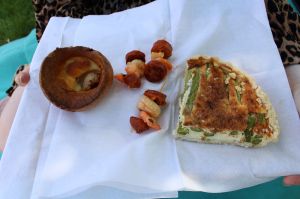Hoy, fui de picnic con mi amiga, Emma, en el Parque Olímpico Reina Isabel, por la primera vez desde el inicio del distanciamiento social en el Reino Unido. Aunque no fue un evento muy difícil o caro de organizar, y bajo otras circunstancias hubiera sido casi cotidiano, debido a las circunstancias bajo las cuales nos vimos, este picnic parecía más como una cena de gala, que merece este artículo de blog.
Today I had a picnic with my friend, Emma, in the Queen Elizabeth Olympic Park, for the first time since social distancing started in the U.K. Although it wasn’t a particularly difficult or expensive event to organise, and would have actually been quite quotidian had we had it at any other time, because of the circumstances in which we met, this picnic had a sense of occasion and celebration, which I feel merits this blog post.

Antes de ir de picnic, cociné algunas cosas: ‘sapitos en el agujero’ (mini ‘toads-in-the-hole‘, es decir ‘Yorkshire puddings’ con salchichas adentro); brochetas de chorizo, vieiras y gambas; tarta de espárragos y queso gruyer; ensalada de patatas; guacamole y palomitas. Aquí os doy las recetas para unas de estos platos. (Quizá algunos de vosotros reconoceréis que la receta para la pasta de masa corta es semejante a la receta de Paul Hollywood.)
Before going for the picnic, I cooked a few things: mini toads-in-the-hole (i.e. Yorkshire puddings with sausages inside); skewers of chorizo, scallops and prawns; asparagus and Gruyère cheese quiche; ensalada de patatas; guacamole and popcorn. Here are the recipes for some of these dishes. (Some of you may recognise that the short-crust pastry recipe is similar to Paul Hollywood’s.)
Tarta de espárragos y queso gruyer/ Asparagus and Gruyère cheese quiche

Ingredientes
Para la pasta de masa corta
- 225 g de harina sin levadura
- Una pizca de sal fina
- 60 g de mantequilla fría sin sal, cortada en dados de aproximadamente 1 cm
- 60g de grasa fría, cortada en dados de aproximadamente 1 cm
- 2,5 -3 cucharadas de agua muy fría
Para el llenado
- 300g de espárragos, recortados y cortados por la mitad
- 200ml nata para montar
- 2 huevos grandes batidos
- 50g queso gruyer, finamente rallado
Ingredients
For the pastry
- 225g plain flour
- Pinch of fine salt
- 60g cold unsalted butter, cut into roughly 1cm dice
- 60g cold lard, cut into roughly 1cm dice
- 2.5-3 tbsp very cold water
For the filling
- 300g asparagus, trimmed and cut in half
- 200ml double cream
- 2 large eggs, beaten
- 50g Gruyère finely grated
Preparación
1. Pon la harina en un cuenco y mézclalo con la sal. Añade la mantequilla y la grasa y mézclalas con la harina usando la punta de los dedos hasta que la mezcla parece como las migas de pan finas.
2. Luego añade suficiente agua fría para unir la masa. Cuando se convierte pegajoso, amásalo suavemente en una bola. Envuélvelo en papel film y ponlo en la nevera durante 30 minutos.
3. Mientras tanto, cocina al vapor los espárragos durante 4 a 5 minutos, sazonados con un poco de sal.
4. Calienta el horno a 200°C (horno de convección) y prepara un molde de tarta redondo estriado antiadherente de base suelta de 20 cm, de 3,5 cm de profundidad.
5. Estira la pasta sobre una superficie ligeramente enharinada a una capa de 3 mm y utilízalo para relinear el molde de tarta, dejando el exceso colgando sobre el borde. Reserva un poco de pasta sin cocinar por si acaso hay que cubrir algunos huecos más tarde. Pincha la base de pasta con un tenedor. Cubre la pasta con papel para horno o de aluminio y luego llénalo con frijoles para hornear.
6. Hornea a ciegas por 15 minutos, luego retira el papel y los frijoles horneados y devuelve la pasta al horno durante unos 5 minutos o hasta que se vea seco y de colores débiles. Recorta el exceso de pastel del borde. Usa un poco de la pasta cruda reservada para cubrir las grietas o los agujeros si es necesario. Baja el horno a 180°C (horno de convección).
7. Para el llenado, bate los huevos y la crema juntos. Añade el queso. Sazona con sal y pimienta.
8. Coloque las mitades de espárragos en la parte inferior de la tarta, luego vierte la mezcla de huevo sobre los espárragos. Cocina la tarta en el horno entre 30 y 35 minutos, hasta que el llenado esté listo y dorado. Déjalo en el molde por 15 minutos y luego desmoldea. Sirve caliente o frío.
Method
1. Put the flour into a bowl and mix in the salt. Add the butter and lard and rub into the flour with your fingertips until the mixture resembles fine breadcrumbs.
2. Then work in just enough cold water to bring the dough together. When it begins to stick together, gently knead it into a ball. Wrap in cling film and chill in the fridge for 30 minutes.
3. Meanwhile, steam the asparagus for 4 to 5 minutes, seasoned with a bit of salt.
4. Heat the oven to 200°C (fan) and have ready a 20cm loose-based fluted tart tin, 3.5cm deep.
5. Roll out the pastry on a lightly floured surface to a 3mm thickness and use it to line the tart tin, leaving the excess hanging over the edge. Reserve a little uncooked pastry in case you need to patch any cracks later. Prick the pastry base with a fork. Line the pastry with baking parchment or foil and then fill with baking beans.
6. Bake blind for 15 minutes, then remove the parchment and baking beans and return the pastry to the oven for about 5 minutes or until it looks dry and faintly coloured. Trim away the excess pastry from the edge. Use a tiny bit of the reserved raw pastry to patch cracks or holes if necessary. Turn the oven down to 180°C(fan).
7. For the filling, whisk the eggs and cream together. Stir in the cheese. Season with salt and pepper.
8. Arrange the asparagus pieces on the bottom of the tart, then pour on the egg mixture. Bake in the oven for 30 to 35 minutes, until the filling is just set and golden. Leave in the tin for 15 minutes, then unmould. Serve warm or cold.
‘Sapitos en el agujero’/ Mini toads-in-the-hole

Ingredientes
- ⅔ de una taza de harina sin levadura, incluyendo 1 cucharada de harina con levadura
- ⅔ de una taza de leche semidesnatada, incluyendo 1 cucharada de agua fría
- 2 huevos
- Una pizca de sal
- Aceite de colza
- 5 salchichas crudas (o 10 salchichas muy pequeñas)
Ingredients
- ⅔ cup of plain flour, including 1 tbsp of self-raising flour
- ⅔ cup of semi-skimmed milk, including 1 tbsp of cold water
- 2 eggs
- A pinch of sal
- Rapeseed oil
- 5 raw sausages (or 10 mini sausages)
Preparación
1. Bate la harina, la leche, el sal y los huevos por la mañana y deja la mezcla en la nevera unas horas (como cuatro horas).
2. Después de unas horas, media cocina las salchichas a la plancha mientras unos 10 minutos que calienta el horno a 220ºC (horno de convección), añade media cucharada de aceite a cada taza de dos moldes de ‘Yorkshire pudding’, y pon los moldes con el aceite en el horno por 15 o 20 minutos. (Yo usé dos moldes de tres tazas, entonces tuve que hacer una tanda de seis Yorkshire puddings, y otro tanda de cuatro Yorkshire puddings.)
3. Corta las salchichas por mitad.
4. Baja el horno a 180ºC (horno de convección) y retira los moldes del horno.
5. Retira la mezcla de leche de la nevera y bátelo de nuevo muy rápido.
6. Pon cada mitad de cada salchicha en una taza con aceite muy caliente en los moldes (tuve que reservar cuatro mitades y repetir etapa 5 hasta el final con esas cuatro mitades).
7. A toda prisa pero con cuidado, vierte la mezcla de leche sobre cada taza con una mitad de salchicha, hasta que rellene cada taza.
8. Vuelve a colocar los moldes al horno y déjalos por 30 minutos hasta que cada Yorkshire pudding esté bronceado en el borde pero bien dorado en el centro.
Method
1. Whisk the flour, milk, salt and eggs in the morning and leave the mixture for a few hours (about four hours) in the fridge.
2. After a few hours, half cook the sausages under the grill for about 10 minutes and pre-heat the oven to 220ºC (fan), add half a tablespoon of oil to each mould in the Yorkshire pudding tins and put the tins with the oil in the oven for 15 or 20 minutes. (I used two tins of three moulds each, so I had to do a batch of six Yorkshire puddings and another batch of four Yorkshire puddings.)
3. Cut the sausages in half.
4. Turn down the oven to 180ºC (fan) and take out the tins from the oven.
5. Take out the milk mixture from the fridge and whisk it very quickly.
6. Put each half sausage in each tin mould with very hot oil (I had to reserve four halves and repeat stages 5 to the end with these four halves).
7. As quickly as possible but with care, pour the milk mixture over each mould containing a half sausage, until each mould is filled.
8. Return the tins to the oven and leave them for 30 minutes until each Yorkshire pudding is bronzed on the edges and very golden in the middle.

Y para terminar el día, disfrute de los tulipanes los brownies superricos que Emma me regaló para agradecerme por la comida.
And to end the day, I enjoyed the tulips and delicious brownies Emma gave to me to thank me for the food.




